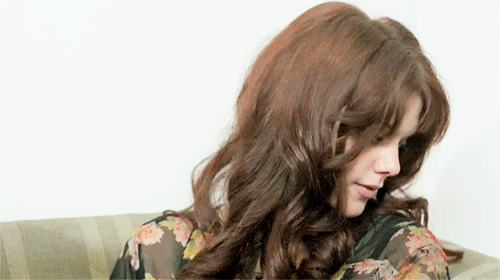
‘Over the course of the past, say, twenty years, I’ve gradually become more and more aware of the late actress Tina Aumont, who died in 2006. She’s one of the great (albeit largely unknown) beauties of the 60s and 70s, and a sort of gorgeous bad girl “Zelig” figure uniting disparate famous people from old school Hollywood types to the Warhol crowd and 60s and 70s European film notables. Truly she was the junkie underground “Kevin Bacon” game connector of the era, if nearly forgotten today.
‘I first laid eyes on the luminous Aumont in Joseph Losey’s Modesty Blaise, but she was billed there under her married name Tina Maquand. I probably first read her name in Richard Witts’ Nico: The Life and Lies of an Icon, his 1995 biography of the Velvet Underground chanteuse. The first time I actually saw Aumont onscreen—and had any context for her—was later that same year when she was an interviewee in the Nico: Icon documentary.
‘So my entré to Tina Aumont was being a big Nico freak, which invariably led to an interest in the films of Nico’s paramour, bohemian French film director Philippe Garrel. Aumont was in several of Garrel’s underground films and was the one who first introduced Garrel—then seen as a sort of cinematic Rimbaud—to Nico in 1969, suggesting that her new music (The Marble Index) would be perfect for his Le Lit de la Vierge. (She gifted him with a version of “The Falconeer” heard only in that film, which starred Aumont, with Pierre Clémenti as Jesus.)
‘Aumont was born on Valentine’s Day of 1946 in Hollywood, California and it was at birth that her first Zelig-style cameo took place: Her mother was the ill-fated “Queen of Technicolor” Maria Montez, the exotic star of such films as Ali Baba and the Forty Thieves and Cobra Woman. (Jack Smith’s notoriously perverse Flaming Creatures is an homage to Montez and the word “camp” was practically coined to describe her flamboyant performances. Kenneth Anger has cited Cobra Woman as his favorite film.) Marlene Dietrich is said to have sung baby Tina to sleep and Jean Cocteau wrote a poem for her (“La Fille aux étoiles”) when she was born. An auspicious birth by any definition, but her mother died of a heart attack at the age of 31 when Tina was just five. Her father was the dashing French actor and war hero Jean-Pierre Aumont.
‘By the time she was 17, with the full approval and encouragement of her father, who thought she was a wild child and wanted to see her settle down, Tina married actor Christian Maquand in 1963. Maquand was a heartthrob actor who was in And God Created Woman playing opposite Brigitte Bardot. He also directed the star-studded adaptation of Terry Southern and Mason Hoffenberg’s Candy. He was 19 years her senior and close friends with director Roger Vadim and Marlon Brando. This is where her social circle really starts to expand. Imagine what a documentary might look like about Tina Aumont, containing as it would film footage and photographs of her at that age alongside of people like Brando, Vadim, Jane Fonda, Roman Polanski and Donald Cammell. The great New York acting teacher Stella Adler. Mick Jagger, Keith Richards and the Stones inner circle: art dealer Robert Fraser, Stash Klossowski and Marianne Faithfull. Bob Dylan. The Who. You get the picture.
‘In 1966 she shot a western with Dean Martin and Alain Delon called Texas Across The River, but around this time she had a miscarriage that Maquand blamed her for and their three year marriage ended. Within the year she’d moved in with artist Frédéric Pardo in Paris where the friends dropping by their psychedelic apartment included Pierre Clémenti, Zouzou, Anita Pallenberg and Warhol “superstar” Viva. The couple then moved to Rome in 1967 where Aumont hung out with Jimi Hendrix and made films with the likes of Klaus Kinski; appeared in erotic filmmaker Tinto Brass’s oddball underground film The Howl, Philippe Garrel’s poetic Le Lit de la Vierge and played opposite Pierre Clémenti in Bernardo Bertolucci’s Godard-influenced Partner. She also appeared in Playboy magazine, shot by Angelo Frontoni with “Rapunzel” length locks.
‘Tina Aumont had a reputation as a hard drug user, but for several years she managed to keep her behavior on film sets professional. Frédéric Pardo said of Aumont that her mother had left her “a very peculiar will. She revealed in it that she had spent time with the devil, as a voodoo practitioner. Tina quickly followed her onto the slippery self-destructive slope…” Despite this, she was still cast in films with Liza Minnelli, Ingrid Bergman and Catherine Deneuve. Tinto Brass (who called Aumont the most beautiful woman he’d ever worked with) cast her in his kinky Third Reich tale Salon Kitty. In 1975 she was in Roberto Rossellini’s The Messiah and played opposite Donald Sutherland in Fellini’s Casanova the following year.
‘But Aumont’s career took a nosedive when she was arrested in Italy in 1978 and convicted with the illegal importation of 400 grams of opium smuggled in tiny Buddhas from Thailand. Aumont was sentenced to three years imprisonment, reduced on appeal to just nine months, but she was deported from Italy and moved back to France. She worked only sporadically after that. Tina Aumont died in her sleep at the age of 60 in late 2006.’ — Richard Metzger, Dangerous Minds
____
Stills
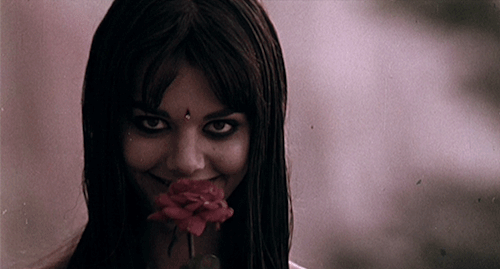


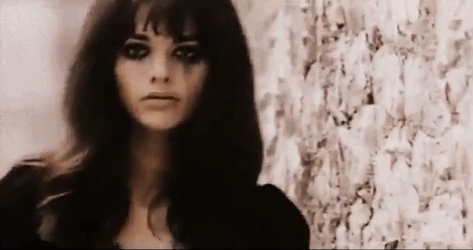








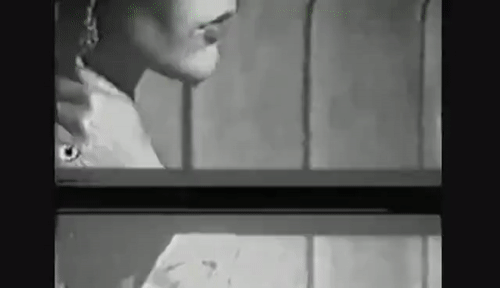







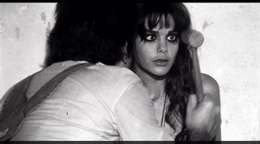












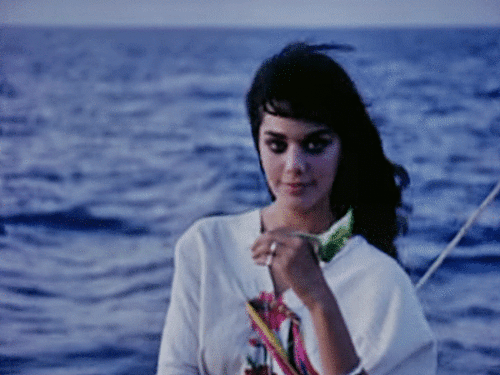


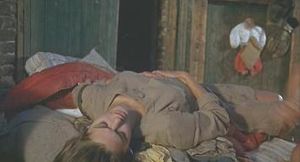
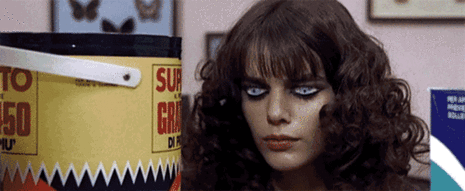
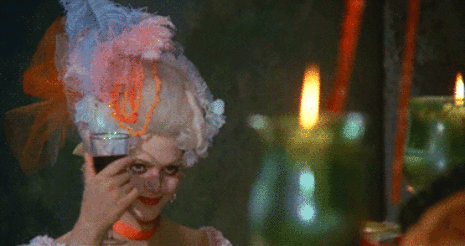

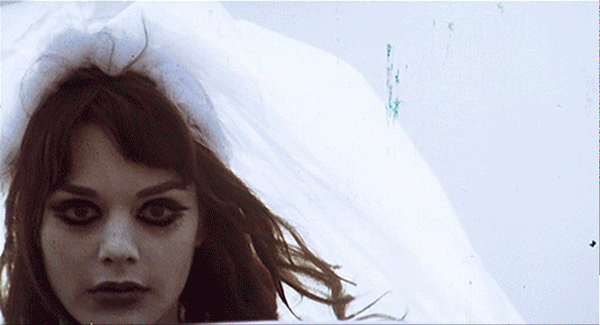
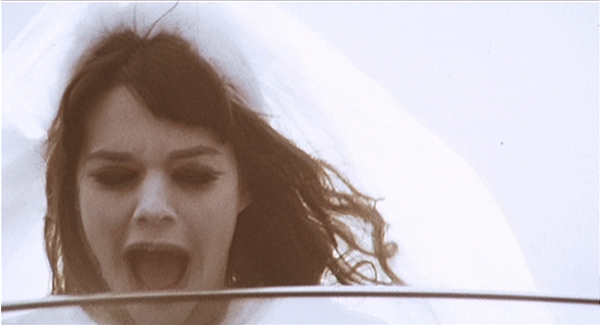
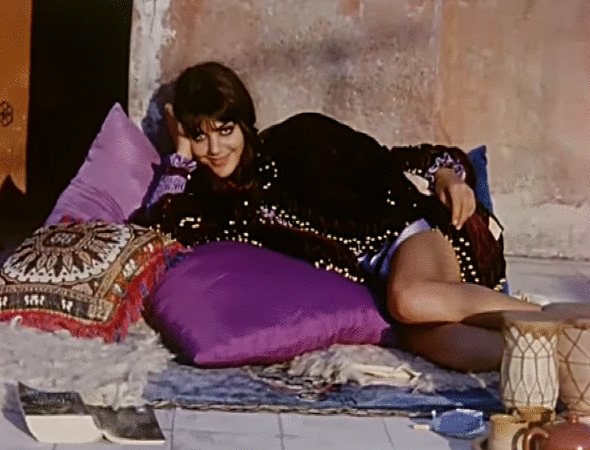







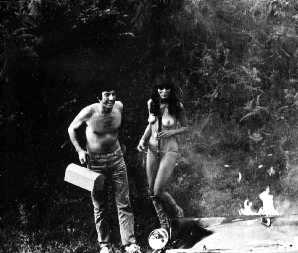
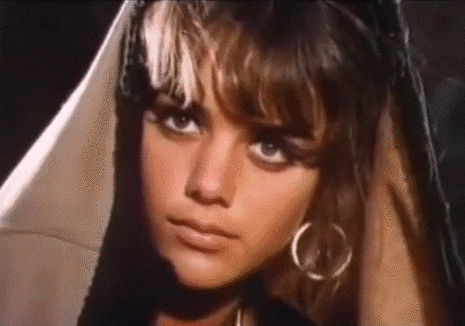
____
Further
Tina Aumont tumblr
Tina Aumont Tribute Page
Tina Aumont page
Tina Aumont @ IMDb
Tina Aumont @ blacklodge
Tina Aumont @ infinitetext
TINA AUMONT, NUIT SANS ÉTOILE
Tina Aumont’s grave
Waiting for Tina
“Torso”: Enter If You Dare the Bizarre World of the Psychosexual Mind
Tina Aumont @ MUBI
Fragments d’un dictionnaire amoureux: Tina Aumont
“The Girl with those Eyes”
Tina Aumont @ Sens Critique
____
Extras
Tina Aumont (1985) by Gérard Courant
Clips from Frédéric Pardo’s Home Movie, filmed in Morocco 1968 on the set of Philippe Garrel’s Le Lit de la Vierge.
______
How I met Tina Aumont
from Romanhattan/KOSMOCHLOR

It was some time around the turn of the millennium. Film producer and actor Ivan Galietti, an Italian friend transplanted in New York, had come to Paris for one of his frequent visits to Tina, who was fifty-four or fifty-five and looked ten years younger.
She was one of the kindest persons I’d ever met. How, I wondered, can this woman be a myth of the twentieth century, and be so easy-going, so approachable, like the girl next door.
The first thing that struck me was her eyes, immense, dark, soulful. Age tarnishes most beauties, but her face, dominated by those incredible eyes, remained unlined. Her youthful looks weren’t the result of the surgeon’s scalpel. Even if she had needed to negotiate with time, which she did not, she couldn’t have afforded the cost.
She could afford pretty much … nothing. After her glory days, her father’s heritage in the hands of her stepmother, an Italian actress, she was reduced to living in a minuscule apartment located in a modest Parisian quarter full of penniless immigrants, and the rent was paid by the city’s social services. Tina’s flamboyant career had taken a downturn in the late seventies, when she was banned from Italy, her country of adoption, for drug possession. Leaving Italy had broken her heart.
Tina worked with great directors like Fellini, scandalous directors like Tinto Brass, who said she was the most beautiful woman with whom he’d ever worked, and many others. Several among the films in which she starred were intellectual and elegant, other fell into the category of B movies. To all her films, she brought her magnetic, compelling presence.
But Tina loved the needle, and little by little her contracts dwindled to nothing. The French television tried to lure her back into acting, but she seldom kept up with the schedule, and when the dressers prepared her for a scene, they could see the needle holes constellating her arms.
The day I met Tina, Ivan, my boyfriend Pierre and I set off with her for a promenade in the forest of Fontainebleau, half an hour or so to the south of Paris. Before leaving, we had a couple of beers in a café. She had water, an entire bottle. At the time, she was already treated for respiratory problems, but she rolled joints in full sight on the café table, and she smoke the first in a taxi, to the driver’s despair. Unabashed, she rolled down the window and puffed on.
The second time I saw her, it was at her funeral in Paris, Cimetière du Montparnasse, on the 18th of November 2006.
Paris had gifted us with one of those wonderful autumn days, sunny and warm. I arrived early, and Ivan was nowhere in sight. Tina’s friends had gathered in front of the entrance. Knowing nobody, I waited on the opposite side of the street. The crowd stared at me, a few heads put together, whispering. What crosses your mind when, during a ceremony, a bunch of strangers can’t pull their gazes off you? I wondered whether I had picked the right clothes for a funeral. I tugged uncomfortably at my black sweater, glanced down at my long skirt, grey with black arabesques, and light-brown leather boots, but could find nothing wrong with my attire, and tossed my grey shawl over my shoulder, to give myself a countenance.
Ivan arrived at last, in time for the crowd to move over to the grave. As these gatherings go, a few friends recounted their memories of the deceased. Ivan read a poem he’d written for Tina.
I remember the anecdote told by Nadine Trintignant (sister of Tina’s first husband, Christian Marquand). In a scene, Tina, standing before the camera, was supposed to start walking to the right. During the first take, she walked off to the left. “Cut!” director Lina Wertmuller ordered. “Tina, you know you should walk to the right.” Tina nodded. “Okay.” The camera rolled, and Tina walked to the left. “To the right, Tina, please!” Tina smiled. “To the right. No problem.” And off to the left she went. Take after take, there was no way to convince her to walk as the script demanded. It’s not that she refused to comply, but some daydream held her in a firm grasp. Finally, one of the grips lay down on the floor, out of the camera’s view, and gently turned Tina’s feet to the right, and she stepped in that direction.
After the funeral, Ivan and I followed Tina’s friends to a bistro. Someone showed me one of her last photographs, taken in the hospital. Despite the oxygen tubes, she hadn’t changed a bit. At sixty, she still looked young.
Now was the moment to enquire about the strange gazes pinned on me when I arrived at the cemetery. So I put the question to the woman sitting next to me.
She answered: “You looked so much like her, we thought Tina had found the way to attend her own funeral. It would have been typical of her.”
“I look nothing like her.” I was going through one of my dark-hair phases, when I dye my reddish-brown hair dark brown or black, with a long fringe (or bangs, my American friends would say), and I’d hidden my eyes behind large sunglasses. But still.
“I can see it now,” the woman said. “But the silhouette and the hair were so similar we really thought her ghost had come to say goodbye.”
Goodbye, Tina. You aren’t forgotten. Walk free, in the direction of your desire. Maybe I’ll see you around Paris, some day.
___________
16 of Tina Aumont’s 57 roles
___________
Joseph Losey Modesty Blaise (1966)
‘Tina Aumont began her career by chance in the movie “Modesty Blaise” by Joseph Losey under the name of Tina MARQUAND, her name of wife (she was married from 1963 to 1967 with Christian MARQUAND, the brother of Nadine TRINTIGNANT) before resuming his maiden name after her divorce. Her character is stabbed in the stomach by one of Dirk Bogarde’s henchmen in a marketplace; she dies shortly afterwards with Monica Vitti kneeling by her side.’ — collaged
Trailer
_____________
Pierre Clementi Visa de censure n° X (1967)
‘I must have taken LSD without realizing it… It seems Clémenti made a whole portrait about an epoch in this short movie, covered with neon light, symbolism, rituals, esotericism, student movements, friendships, partnerships and many drugs, at the improvisation sound of guitar, trumpet, besides indian music (of course!). Images jump off the screen without having any type of connection among them, they fade into frenzy and apparent confusion of memory… Transmitting us detachment, sensitivity and ‘transcendentalism’ through drugs (something conceptualized by the spirit of that time), brings us to stunning sensations, amidst memories and records of its creator.’ — Luana Pinheiro

____________
Bernardo Bertolucci Partner (1968)
‘In PARTNER, Bernardo Bertolucci conflated his interests in psychoanalysis, nonlinear narrative, and Godard to create a uniquely avant-garde work unlike anything in his ouevre. The film is loosely based on Dostoyevsky’s novel THE DOUBLE and concerns an alienated, puckish young man named Jacob (Pierre Clementi) who confronts his own double. Jacob allows his doppelganger to take over his life; the second Jacob commandeers his predecessor’s theater class in the hopes of creating living theater–as a violent act of social revolution. The idea of students wreaking havoc was not an unfamiliar one in 1968, and Bertolucci refuses to take Jacob’s dangerous intellectual posturing lightly. The second Jacob is a handsome killer, the first a handsome weakling who must find the courage to resist his baser self. Bertolucci matches inspired plot points with arresting images, including visual film references and the bright color schemes that would later become his trademark.’ — letterboxd
Excerpt
____________
Tinto Brass L’Urlo (1968)
‘Drawing its title and a dash of inspiration from Allen Ginsberg’s famous beatnik classic, The Howl (L’urlo) is easily the most freewheeling and unjustly ignored title in the Tinto Brass canon, with plenty of the auteur’s own obsessions and stylistic flourishes congealing into an avant garde snapshot of late ’60s global unrest that still resonates today. Mixing anti-war sentiments with a flurry of rapid-fire pop culture references, atrocity footage, abundant nudity, and even oddball comedy, this oft-censored psychedelic madhouse has never before been seen in English and will blow away anyone ready to groove along with its unique, inspirational rhythms. Tina Aumont stars as Anita, a lovely young woman escaping the oppression of modern-day society in a globe-hopping travelogue that rivals anything by Alejandro Jodorowsky for sheer mind-melting strangeness. Brass himself admits there wasn’t really a script per se, as the film was shot more like a voyage with a vague framework for the actors; thus it’s a real “trip” in the truest movie sense, grabbing the viewer by the throat from the opening frames and never letting up for an hour and a half.’ — mondo-digital.com
Excerpt
____________
Philippe Garrel Le Lit de la Vierge (1969)
‘Filmed in the smoldered ashes of the failed social revolution as Garrel and a community of young artists from Zanzibar film (a film collective of like minded, radicalized artists financed by heiress Sylvina Boissonnas) abandoned the emblematic barricades of domestic protest and retreated to Africa to transfigure their ideological disappointment into subsumed cultural action through the creation of an intrinsically personal, revolutionary cinema, Le Lit de la vierge is, in a sense, the reconstitution of a fevered, post-traumatic creative manifesto – an impassioned, reflexive apologia composed in the fog of a drug-fueled delirium that not only reflected a not yet resigned sentiment of implicit denial over the failure of the revolution, but also served to reinforce the counter-culture generation’s delusive posture as alienated and discarded messianic ideologues who, nevertheless, continue to hold the keys to an ever-receding utopian paradise.’ — strictly film school
Excerpt
____________
Federico Fellini Satyricon (1969)
‘”Fellini Satyricon” was released in 1970, and I was ready for it: “Some will say it is a bloody, depraved, disgusting film,” I wrote in a fever. “Indeed, people by the dozens were escaping from the sneak preview I attended. But `Fellini Satyricon’ is a masterpiece all the same, and films that dare everything cannot please everybody.” Today I’m not so sure it’s a masterpiece, except as an expression of the let-it-all-hang-out spirit of the 1970 world that we both then occupied. But it is so much more ambitious and audacious than most of what we see today that simply as a reckless gesture, it shames these timid times. Films like this are a reminder of how machine-made and limited recent product has become.’ — Roger Ebert
Trailer
Behind the scenes
____________
Tinto Brass The Howl (1970)
‘Just viewed “The Howl” in its entirety on the big screen at the Egyptian Theater here in Hollywood tonight. Aptly named. Italian Freakout ’70. Makes “Gas-s-s-s” (1970) look like a brief Sunday school production. Some very compelling scenes. But a bit of an endurance test. Avoid if you can’t take watching a duck get its head lopped off in closeup (the lady behind me didn’t like that too much). Lots of nudity, lots of talking, a fair amount of violence, and, being a late-60’s/early-70’s movie, lots of people running around outside. Zero story. Big on visuals, social commentary, and ideas. Surreal, somewhat disturbing, at times beautiful. They sure don’t make ’em like this any more. Pretty interesting soundtrack, as well.’ — dianevallere
the entire film
____________
Franco Brocani Necropolis (1970)
‘Brocani conjures together all your favourite European cultural and historical myth figures in order to attack the centuries of ‘sublimation’ that have produced our cities and their inhabitants. The gang’s all here: Frankenstein’s monster gropes towards the awareness that his mind is a universe; Attila, naked on a white horse, liberates his people from their ignominy; the ultra-caustic Viva bemoans the frustrations of married life and drifts into the elegiac persona of the Bloody Countess Bathory; Louis Waldon is a hip American tourist searching for the (missing) Mona Lisa. The range is extraordinary, from stand-up Jewish comedy to a kind of flea-market expressionism. Brocani’s approach is contemplative rather than agitational, which confounds the impatient; Gavin Bryars’ lovely Terry Riley-esque score matches the ambience exactly.’ — RareFilm
Excerpt
Louis Waldon & Tina Aumont Behind the Scenes of Necropolis
____________
Sergio Martino Torso (1973)
‘Torso (Italian: I corpi presentano tracce di violenza carnale, lit. ‘The Bodies Bear Traces of Carnal Violence’) is an Italian giallo film directed by Sergio Martino. George Anderson of the Pittsburgh Post-Gazette deemed the film “another display of softcore sex and seamy violence that might better have been kept abroad.” Joe Baltake of the Philadelphia Daily News wrote: “Blood flows freely and limbs detach easily, in Sergio Martino’s Torso, a disagreeable Italian import with—not surprisingly—little to recommend it.” The Los Angeles Times’s Linda Gross wrote that the film was a “lazy suspense movie” with a “disjointed and loose” screenplay.’ — collaged
Excerpt
Excerpt
____________
Alexander Whitelaw Lifespan (1975)
‘Cult icon Klaus Kinski features in this dark and intriguing existential thriller. He plays the mysterious “Swiss Man”, ruthless industrialist Nicolas Ulrich, who is obsessed with a search for the elixier of life. He tricks a young American scientist into joining him on his demonic quest. A quest that ends in suicide, death and madness. The story takes place in the atmospheric European city of Amsterdam. Its winding alleys and ancient canals trap the characters in a labyrinthine maze as they find themselves manipulated like figures on a giant chessboard. The film was controversial in its day for the extended bondage scene featuring female star Tina Aumont. This was cut in many countries, but is complete in this version. The brilliant soundtrack, unavailable for over 30 years, is by avant garde composer Terry Riley.’ — rarehorrordvds.com
Trailer
Trailer
____________
Roberto Rossellini Il messia (1975)
‘Virtually unknown outside of Italy, Messiah (Il Messia) is historically important as the last directorial effort of Roberto Rossellini. In retelling the life of Christ, Rosselini harks back to the humanistic style he’d utilized on his many Italian TV projects of the 1960s. The director has no intention of depicting Jesus as being the vessel of divine providence. The Man from Galilee is shown simply as one who is unusually moral and of spotless character — the sort of person who’d be a natural leader no matter who his Father was. Co-scripted by its director, Messiah was completed in 1975, but not given a general release until 1978.’ — Sandra Brennan, Rovi
Excerpt
____________
Francesco Rosi Cadaveri eccellenti (1976)
‘Rosi called Illustrious Corpses “a trip through the monsters and monstrosities of power.” A detective thriller cast in the mold of a political exposé, or vice versa, it is the story of a mysterious killer (or killers) whose victims are judges, public prosecutors, and magistrates. The dogged, Marlowe-like detective who follows this morbid trail uncovers a nest of corruption at every cultural and political turn: every witness—indeed, every institution in Italian society—has a stake in the collapse of the judiciary. Rosi’s most despairing comment on absolute power and corruption is also his most stylistically distinguished. From the famous opening sequence in which the mummified elders stand upright in the catacombs, “Rosi shows such a majestic, ominous spatial sense in this movie that at times it seems to be an architectural fantasy about a country of the dead” (Pauline Kael). Lino Ventura as the melancholy detective is joined by a star cast including Tina Aumont, Fernando Rey, and Max von Sydow.’ — Pacific Film Archive
Excerpt
______________
Tinto Brass Salon Kitty (1976)
‘Salon Kitty is a 1976 erotic-war-drama film directed by Tinto Brass. The film was coproduced by Italy, France and West Germany. It is based on the novel of the same name by Peter Norden, covering the real life events of the Salon Kitty Incident, where the Sicherheitsdienst took over an expensive brothel in Berlin, had the place wire tapped and all the prostitutes replaced with trained spies in order to gather data on various members of the Nazi party and foreign dignitaries. It is considered among the progenitors of Nazisploitation genre. In the U.S., the film was edited to lighten the political overtones for an easier marketing as a sexploitation film and released under the title Madam Kitty with an X rating.’ — collaged
Trailer
______________
Federico Fellini Casanova (1976)
‘Federico Fellini’s Casanova, which chronicles the life of its eponymous hero from shortly before his imprisonment in the Piombi in Venice to his old age in the service of Count Waldstein in Bohemia, is a remarkable and deeply affecting masterpiece. Filled with lavish, often peculiar, and highly stylized sets, ablaze with the ornate, vibrantly colored costumes worn by the actors, and suffused with a delicious sense of sadness tinged with a cold humor, the movie is consistently mesmerizing both visually and narratively. There is not a moment of his brilliantly realized film to which Fellini has not given a truly intoxicating loveliness. From its opening sequence depicting the celebration of the Doge’s marriage to the sea, in which a colossal statue of Venus is raised up from the waters of a canal amidst fireworks, while hosts of masked onlookers crowd the surrounding bridges and walkways, until its conclusion, in which the protagonist dances with a mechanical woman under a night sky, the director has created a work that is so astonishingly beautiful it is more like a revelation, in quick succession, of a series of paintings done by some great master than it is like most other films.’ — MOVIERAPTURE
Excerpt
________________
Jacques Richard Rebelote (1984)
‘The tale of a sad delinquent trying to overcome his miserable childhood to find success at love and life. It stars Jean-Pierre Léaud, Christophe Bazzini, Olga Georges-Picot, Jacques Robiolles, and Tina Aumont.’ — collaged
Trailer
_______________
Jean Rollin Two Orphan Vampires (1997)
‘Rollin’s entire filmography, more or less, could be summarized as a poetical consideration of death, termination, and unreality, but coming to terms with his own pending death had a way of affecting how he regarded them (the film was undertaken just as he was diagnosed with kidney failure). Something previously conceptual and child-like, nostalgic and precious in Rollin’s work becomes more concrete and dimensional, unflinching and adult. When they commit one violent transgression against their kindly benefactor, the scene’s abrupt and awkward brutality recalls the best of Henri-Georges Clouzot.’ –Fab Press
Trailer
*
p.s. RIP Roky Erickson. ** David Ehrenstein, Hi. So sceptical! Should I play retroactive Cupid and hook you up with TheSkeptic? ** Bill, Hi! Oh, yes, I wondered why you were so mute. Welcome back! Well, Puce Mary lives in LA, so there’ll probably be SF opportunities, galore even. When’s your gig? There could be Berliners reading this thing that need your special form of enlightenment. ** Sypha, Hi. Ha ha, I also know you’re a bit of a sucker for the ones who look like they’re 13 years old. Yeah, I’m down for the ‘Godzilla’ movie. Lots of a bad reviews but they’re mostly on the order of ‘it doesn’t make sense’, and … who in the world cares if a Godzilla movie makes sense? Jesus. ** _Black_Acrylic, Hi, Ben. I know, right? That was a real find, that SherlockHomo array. Steal it for The Call. He’ll never know. Yes, lots of mega-raves about that Chernobyl show. If I watched TV, I might … ** Steve Erickson, Hi. It was a pretty good month on the comments front, I thought so too. As I’ve said, the master/slaves commenting arenas are getting trollier and trollier. And they may the only ‘social media platform’ where that’s a good thing. ** Nik, I know, right? Marriage material, that guy. No, Zac doesn’t want to put his earlier work online for some reason. He didn’t make films before. He worked in video, photography, and in sculpture/installation. Uh, I think the comedy in the films is pretty much a mutual thing. I’m always happy when people pick up on the humor in PGL. It’s pretty thorough, and I’m surprised how many people don’t get it. But then I think my novels have a lot of comedy in them too, and, same thing, a lot of people just don’t register that. The content blinds them or something. I’m not entirely sure how the ltd. ed. thing will work. The gallery said that there’ll be an option to just buy the gif work or also buy the display hardware (screen, keyboard, hard drive). But I don’t know how or if they’re doing some kind of package for the presumed thumb drive that the work will be on. I guess I’ll find out when the art fair happens at the latest. Ah, shame that you can’t do that talk, but how awesome that she asked. Nice. I like Jelenik, yes. I liked ‘Women as Lovers’. I think my favourite of hers is ‘Lust’, at least in memory. Have a swell weekend! ** Right. I’m giving the blog over this weekend to the cool and riveting French actor Tina Aumont. I’m not sure how known she is outside of France, but I know at least some of her films are. She’s terrific. I hope you’ll get into it. See you on Monday.




 Now available in North America
Now available in North America 
Dennis! I have never heard of Tina Aumont and feel derelict, thank you. Also, the slaves are rich this month. My faves are split between the fantastic “Not actually a Jew” and the comment quoting The Knife’s “Pass This On.” My novel uses a Fever Ray line as an epigraph because she (and the Knife) are so goddamn good.
Speaking of my novel (nudge, nudge) I commented on a post earlier this week but I think it got lost to the God of Time Zones. Anyway, my publisher has asked me who I know who might like to see a bound manuscript/fancy PDF of the book and you came to mind right away. It’s got southern boys and a murder mystery and a complex interrogation of toxic masculinity and southern boys. I see in your other posts that you’re pretty snowed under, so no rush, but I thought you might enjoy. I arguably wouldn’t be where I am now without your support years and years ago, back when I was a little baby with half a college degree and a dying laptop, so if nothing else I want to thank you for that.
Also, mad congrats on Permanent Green Light, seriously. Some images from that movie have hung around my head ever since I saw it. Funny story, my novel went out to editors while I was on the train coming to see your movie so it’ll always be tied to a special place in my heart.
Best
J
Our friend Meredith Brody was just posting about Tina Aumont the other day on Facebook. I forget exactly how she was brought up. I have a Frederic Pardo poster for Garrel’s “Le Beceau du Cristal” starring Nico and Anita Pallenberg. It was given to me by Jacques Demy’s lover David Bombyck just before he died. Tina Aumont is quite terrific in the “Nico/Icon” documentary. Junlies otn relae to one another with great camaraderie
“The Skeptic” reminds me of the “Straight But Easily Seduced” dudes of my high school days.
Great to see that clip of Viva with Carmelo Bene. She lives in Palm Springs and post frequently on Facebook about politics
Demmis, look like they’re 13? Pshaw! I’d say 14, ha ha. Well, I can only work with what I’m presented.
Yeah, I hear you on the Godzilla thing. It kind of reminds me of the last few seasons of GAME OF THRONES, where you have this world with dragons and zombies and ice demons and people who can change their faces, but you also have nerds complaining about the lack of “logic.” This is something that’s depressingly common when it comes to fantasy and comic book fans, I’ve found, in that, despite the fantastical nature of the artwork they gravitate towards, they seem to show a real lack of imagination, and seem to have this autistic desire that all the dots connect in a realistic way. But TV and movies are, obviously, a visual medium and sometimes you just need to go for the cool visual, logic and realism be damned! I don’t know.
But yeah, I’ve also been reading how people complain that there are too many human scenes and not enough monster scenes, but really, almost every old Japanese monster movie is like that. This used to drive me crazy when I was a kid, like an hour of boring humans doing stuff while waiting for the monsters to arrive, yet when the monsters DID arrive it had a bigger impact because of that waiting period before hand. You k now what I mean? In any event I’ve been a Godzilla fan my whole life and I’m just happy to see the big guy still appearing on the big screen and kicking ass. And I’m very excited that this film will bring in some of the other Godzilla friends and allies, like Mothra and the (underrated) Rodan.
Seeing the words “Modesty Blaise” reminds me that that was the book that John Travolta was reading before getting killed in PULP FICTION. I mention this because my brothers and I began doing a Tarantino marathon recently and currently we’re up to PULP FICTION.
I like that movie ‘Lifespan’ – funny how things work out. I bought the soundtrack because Terry Riley does it. Then saw it was a Kinski film and tracked it down.
If you haven’t listened to the soundtrack- https://youtu.be/9YgWvgAd0GQ
Hi Dennis.
That ‘Lifespan’ movie is worth checking out as the soundtrack is by Terry Riley – https://youtu.be/9YgWvgAd0GQ
Also – ‘Salon Kitty’ is just the sick greatest.
Walt Whitman was Gayer Than IKEA on Superbowl Sunday
Tina Aumont isn’t in any of that “Fellini Satyricon” footage because she wasn’t in that film but rather in this rival “Satyricon” made at the same time.
Wild seeing Max Born singing Bob Dylan. No one seems to know what became of Max after Fellini.
Dennis, Yeah, I wasn’t aware of the Real ID thing either until a dude at work was crying about it. I looked into it, and sure enough, I have to show up there on the 25th of June -I set up the appointment- with a bunch of fucking documents to prove I am who I am. Crazy.
A lot of states got waivers to delay it, but with the October 1, 2020 final date approaching, they’re all scrambling to comply.
Bunch of bullshit if you ask me.
I went to see Rocketman yesterday. You know what? Not bad. Really. They did have some musical dance numbers that were odd -you know me, I can’t stand that shit- but they fit in and all, and they became less and less as the movie wore on and it all became more “fantasy.” Otherwise, it was pretty good, much better than that shit Bohemian Rhapsody movie. Just a better put-together film.
Of course, I had to look up some things afterward, and liberties -outright lies, actually- were taken with some things. But the acting was good and it was a fun little movie. Probably a plane movie for you if absolutely nothing else is in the queue. I mean, I won’t be seeing it again. 😛
I’m reading Mary Renault’s first Alexander the Great novel, Fire from Heaven, and really enjoying it. I’m a big Alexander fan. Read her second of the trilogy, The Persian Boy, first. This covers his childhood and coming of age and is really interesting. I like, too, how she just makes him out-and-out gay. Mary ain’t give a fuck, hahaha.
Tina Aumont seems a fascinating person who would have had a fair few stories to tell. I do really need to see Nico Icon, especially as the whole thing’s up on YouTube. In fact that’s tonight’s viewing sorted, nice one.
Issue #2 of The Call continues to take shape. The cover artist this time will be the illustrator and and Yuck ‘n Yum veteran Paul Jon Milne who can always be relied upon to contribute something spectacular. His image is blue so I’m minded to have all the text for this edition printed in blue ink, which I can imagine looking quite splendid. We go to press this Friday so I’m just hoping to get all the work in for then.
I wonder what was going on with the “not actually a Jew” guy.
Have you seen the HBO show BARRY? I’ve now seen 6 of its 2nd season’s 8 episodes, and I’m really impressed with it (although the fifth episode, directed by co-creator/star Bill Hader, has a surreal/nightmarish feel that seems more “cinematic” than the rest of the series.) It seems to be riffing on post-Tarantino ’90s American cinema and SOPRANOS-inspired anti-hero TV, with a protagonist who is a hitman that thinks he can find a new life as an actor, but the second season has moved away from the more gimmicky aspects of that premise towards a darkly comic but ultimately serious look at someone trying setting out change his life for the better but failing. After I’ve made it through this season, I plan to start watching CHERNOBYL on HBO streaming.
Latest BaBlog: Nastypants!
I’ve seen some of these films (most recently “Modesty Blaise”) but never realized who Aumont was. Probably my three biggest fetishes are bicycles curls and analog synthesizers so I hope the video store has “Lifespan.” Just from the trailer I suspect it was an inspiration for “Tess.”
My Gena Rowlands friend has been a font of ideas lately that will strengthen my film school application. Her friend is an Australian-German-Israeli eccentric film scholar currently living in Berlin who would make a worthwhile documentary subject.
Wish me luck with a draft-dodging rascal I’ve been chronically obsessed with. A recent chance encounter and a hexagram I threw indicate we’re on a collision course. This is his music:
https://www.youtube.com/watch?v=8JRIQakfsG0&feature=youtu.be&fbclid=IwAR0B0mEjJETP3lNlR3rvOn3JhiBWtl608HlgpCCOcav3NARj-sQ3QeZ8gTU
Btw a few years ago my folks had an issue where their state IDs weren’t accepted to get onto planes so they used their U.S. passports for domestic travel, as behind-the-Iron-Curtain as that sounds. So I’m almost positive you’ll be fine getting on planes in USA with your passport.
I’m watching “Chelsea Girls” one episode at a time every few days. First impression is it’s kind of like Out 1’s cousin but more overtly proto reality TV?
Hey Dennis, sorry this will be short, since I need to finish packing and head out to the airport. I’ll fill in more details after I get home.
My gig was June 1 at Sowieso, a low-key little bar in Neukoeln which hosts many echtzeitmusik events. I did sound only (very unusual for me in recent years), with the wonderful musicians Michael Thieke (clarinet) and Nicolas Wiese (feedback). We didn’t record, so we don’t really know how it sounded from the audience’s perspective. But it sounds like it was a good listening/playing experience from the stage! (And if we recorded, it might have sucked, haha.)
Sunday was my last day, a whirlwind of seeing friends and going to the big Splitter Orchestra gig, all in the (for Berlin) dizzying heat.
See you in a couple days or 3.
Bill